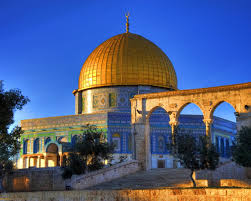
Muslims believe that Prophet Muhammad was shown Heaven and Hell in the second part of the journey, known as Mi`raj.
What Do You Know about Isra’ wal Mi`raj?
Allah the Almighty says in the Ever-Glorious Qur’an what means,
“Exalted is He who took His Servant by night from al-Masjid al-Haram to al-Masjid al- Aqsa, whose surroundings We have blessed, to show him of Our signs. Indeed, He is the Hearing, the Seeing.” (Al-Isra’ 17: 1)
Isra’ and Mi`raj, also known as Al Isra’ wal Mi`raj, is observed on the 27th day of the month of Rajab, the 7th month in the Islamic calendar. This event marks the night that Allah (God) took Prophet Muhammad on a journey from Makkah to Jerusalem and then to the 7th Heaven.
Isra’ and Mi`raj (Night Journey and Ascension to Heaven) marks the night that Prophet Muhammad traveled from Makkah to Jerusalem, ascended to Heaven and returned.
What Do People Do?
Customs around Isra’ and Mi`raj vary between different Islamic communities. Some people spend the evening or night listening to or studying the story of Isra’ and Mi`raj in a mosque or at home. They may also decorate their homes or communities with candles or small electric lights and share food, particularly sweets, with each other or prepare a communal meal. People in some communities make a special effort to include children in the celebrations and explain the story of Prophet Muhammad’s Night Journey.
Public Life
Though Isra’ and Mi`raj is a public holiday in many Islamic countries, it is not a public holiday in countries such as Australia, Canada, the United Kingdom, and the United States. However, there may be some local congestion in the evening on roads around major mosques in Islamic countries.
Background
The Prophet Muhammad lived in and around the area that is now Saudi Arabia in the years 570 CE to 632 CE in the Gregorian calendar. According to Islamic belief, God (Allah) took him on a two-part journey sometime around the year 620 CE. The first part of the journey, known as Isra’, was from Makkah to the “farthest” mosque. This is believed by Muslims to be the Dome of the Rock (Masjid Qubbat As-Sakhrah) in Jerusalem, Palestine.
Muslims believe that Prophet Muhammad was shown Heaven and Hell in the second part of the journey, known as Mi`raj. He talked with many prophets, including Jesus and Moses, in Heaven. He also received instructions on Islamic prayer. Prophet Muhammad returned to Makkah before the end of the night. His journey is remembered and commemorated on Isra’ and Mi`raj.
The Isra’ and Mi`raj are the two parts of a Night Journey that, according to Islam, Muhammad took during a single night around the year 621 CE. It has been described as both a physical and spiritual journey. A brief sketch of the story is in Surah Al-Isra’ of the Qur’an, and other details come from the hadith, which are collections of the reports, teachings, deeds, and sayings of Muhammad. In the Isra’, Muhammad traveled on the steed Buraq to “the farthest mosque”. Traditionally, later Muslims identified the mosque as a location in the physical world, the Al-Aqsa Mosque in Jerusalem. At the mosque, Muhammad led other prophets in prayer. He then ascended to the Heavens in the Mi`raj, speaking to God afterward. The remembrance of this journey is one of the most significant events in the Islamic calendar.
Five facts you should know about Al Isra’ wal Mi`raj
- Al Isra’ wal Mi`raj a major holiday that celebrates the Prophet Muhammad’s (PBUH) night-time journey from the holy city of Makkah to the ‘Farthest Mosque’ in Jerusalem.
- On the Islamic calendar, Al Isra’ wal Mi`raj is generally observed on the 27th day of the month of Rajab, according to the Hijri calendar.
- This day is of significance for two major reasons. Al Isra’ wal Mi`raj begins with the Prophet Muhammad at the Kabaa in Makkah. Prophet Muhammad is visited by two archangels who provide him with a winged steed called Buraq who then carries the Prophet to the ‘Farthest Mosque,’ believed by Muslims to be the Al Aqsa mosque in Jerusalem, where the Prophet joins past prophets in prayer. The Prophet then ascends to Heaven where he is told by God of the duty for Muslims to pray five times daily also known as Salat. This practice is still widely followed some 1,400 years later. This second part of the journey is commonly referred to as the Mi`raj, an Arabic word meaning ladder.
- Muslims usually offer special prayers all night in specially decorated mosques and in their homes for seeking the blessings of Allah.
- Many Muslim countries traditionally announce a one-day holiday to observe the holy day.
Read Also:
History of Israel, Jerusalem & Judaism
———
Sources:
 Arabic
Arabic English
English Spanish
Spanish Russian
Russian Romanian
Romanian korean
korean Japanese
Japanese
